ANN ARBOR, Mich. — Genesis has garnered the attention of the automotive industry, from observers and enthusiasts like ourselves, to that of its competition. The stunted brand rollout may have raised questions at first, but the cars we’ve driven — especially the sporty, well-balanced G70 — speak for themselves. A North American Car of the Year win, favorable J.D. Power owner surveys and Autoblog’s own praise — even in some “Spend My Money” segments of our weekly podcast — have joined the chorus of enthusiasm for a brand that brings a different kind of luxury to the conversation. Now, the car that started it all, the Genesis G80, gets its first total redesign since the brand it inspired got off the ground (the last G80 started life as the second-generation Hyundai Genesis). It feels like a debutant ready to make its splash in the world. You may not have paid much attention to the G80 until now, but the new generation ought to change that.
The 2021 Genesis G80 has presence, whether seen in studio photos, mixing it up in traffic or just resting in the parking lot of your favorite restaurant. It exudes confidence and decorum without outright flashiness or gimmickry. The dimensions and proportions make it appear sizable, its personality stretching to every extremity of its sheet metal. The few character lines are placed with moderated elegance, letting the car’s physique tell its own tale of space and stability. The lines of the badge’s wings seem to stretch around the car from the two horizontal lines of the headlights, to those on the fenders behind the front wheel, continuing invisibly until they reappear where the taillights wrap around the rear corner. The roofline meets the rear deck tidily just above a chrome accent that looks like wings spread wide across the top or the trunk face. The G80 might not scream “look at me” in a crowded parking lot, but it does look fit and polished standing at attention.
The G80’s cabin picks up the story artfully. The wide, horizontal dash is garnished by a wooden trim piece that echoes that earlier wing design. Surfaces are layered with inlays that add character without producing visual clutter. Touchpoints like the steering wheel, rotary gear shifter, center console and door armrests reflect the solidity of the exterior proportions. And, of course, there’s lots of space, just as the external architecture promises.
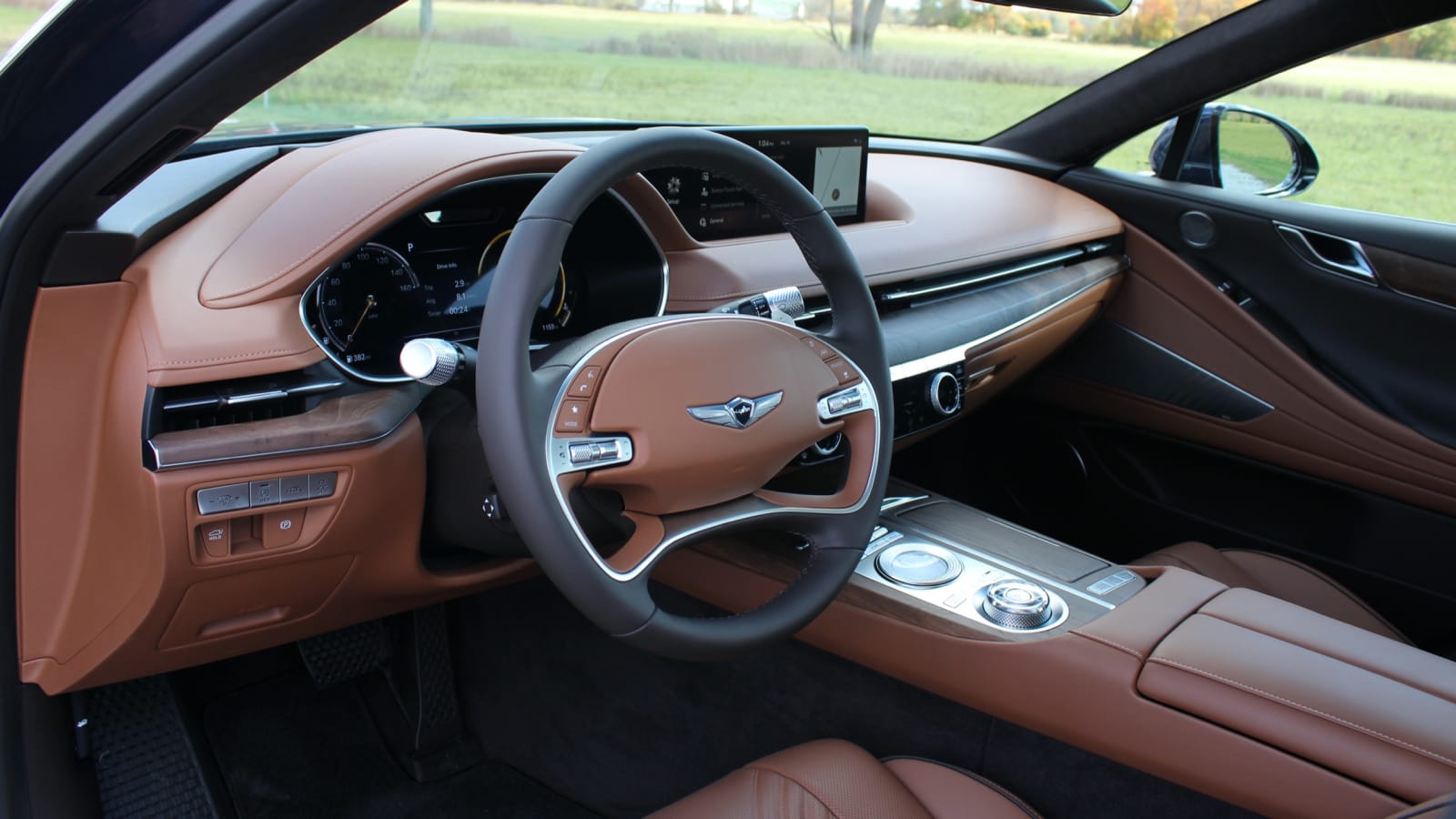
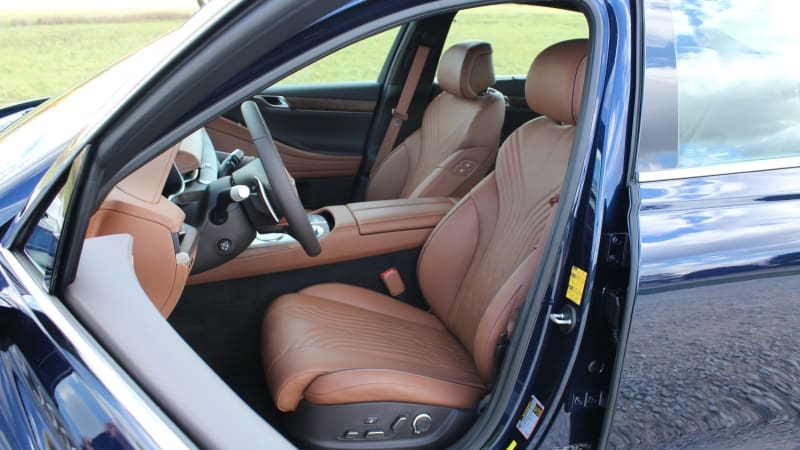
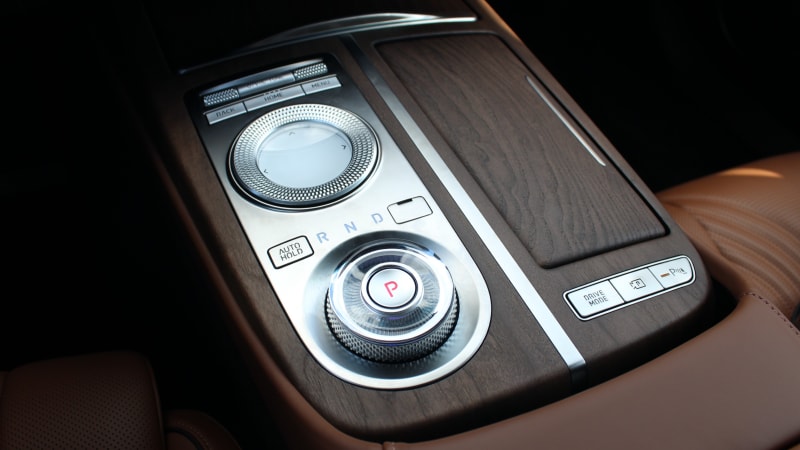
Occupants are treated to quality materials applied with delightful design. The feel is cleaner and more conservative than the likes of BMW and Mercedes, but warmer and less clinical than Audi and Volvo. Layout is straightforward, and we didn’t find ourselves hunting through the cabin for controls. The seats are comfortable, and the Ergo Motion driver’s seat (part of the Prestige package) features air cells that adjust based on drive mode and posture. We couldn’t tell if or when it was working — your author’s backside isn’t that discerning — but we did feel well supported the entire time. The front seats are heated as standard, while ventilation is available along with heated rear seats and steering wheel. We had to flip a child’s car seat on its side to fit through the door, but there’s plenty of room for kids — or adults — to stretch their legs without kicking the seatbacks, and the panoramic sunroof maintains a sense of openness throughout the car.
There are two powertrain options to motivate the new sheet metal and its properly cosseted occupants. First is a 2.5-liter turbocharged inline-four producing 300 horsepower and 311 pound-feet of torque. The 2.5T RWD is rated at 23 mpg city highway, 32 mpg highway and 26 combined, while the 2.5T AWD gets 22/30/25 mpg. Genesis expects this to be the volume seller, with a take rate around 70%, and we’d expect those buyers to find its output to be nothing less than ample, especially if fuel economy is a concern (and remember, all those European competitors also come standard with four cylinders). If you’re looking for the silent runabout, this is your motor, as it nary makes a peep in normal driving. The one weakness in this otherwise solid engine a hesitation under duress. When gunning it, there’s a pause that feels like turbo lag (perhaps due to traction control or other electronic mitigation) before the car catches up to your right-pedal input. If you’re not a heavyfoot or constantly in a hurry, it won’t bother you.
Comparatively, the upgrade option — a twin-turbo 3.5-liter V6 — is more assertive, with 375 horsepower and 391 pound-feet on offer at the loss of just 4 combined mpg. It doesn’t hesitate like the 2.5 to get underway, and pulls smoothly up the revs. It also knows when to make its voice heard. Chiefly under hard acceleration, its smooth baritone soundtrack filters its way into the cabin, then recedes into the background once at cruising speed. With the extra power, we also found ourselves more apt to reach for the paddle shifters to enjoy the quick, smooth shifts of the G80’s eight-speed transmission. The 3.5T also comes with an electronically controlled suspension guided by a road-scanning camera (a technology first seen on the current Mercedes S-Class). While we wouldn’t say you need the extra power, responsiveness and suspension prowess, we wouldn’t try to steer you away from spending the extra $11,400 to move up to the V6 and everything it brings with it.
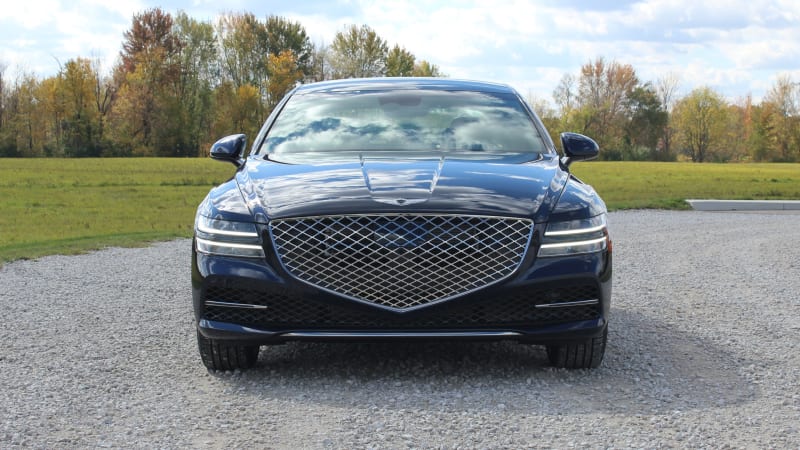
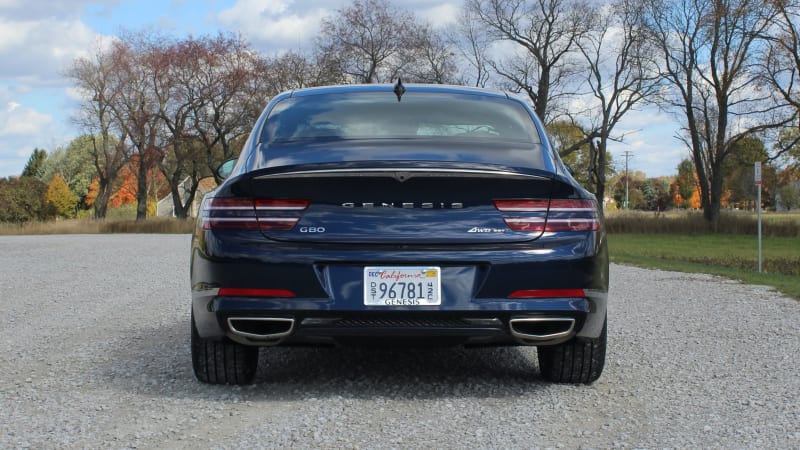
Regardless of powertrain, the ride is compliant without being bouncy or floaty, but the 3.5T’s more advanced suspension does add a healthy dose of refinement. The chassis’ ability to sort out the imperfections and the noise from the road is admirable, even as surfaces change from smooth tarmac to pocked pavement to loose gravel. There’s still enough tautness in the suspension to give it a sense of musculature as weight shifts through the corners, and though the steering weight feels artificial, it still communicates lateral grip from the tires. The all-wheel drive and stability control help keep things calm, too, guiding the nose around gravelly bends out on the colorful country roads of our route.
If the looks, luxury and performance didn’t quite pique your interest, the G80’s interesting technology might. The focal point of the infotainment system is a wide, 14.3-inch touchscreen. Additionally, you can use the rotary controller to navigate menus. It’s a bit like an old iPod in that regard, but its center is also a touchpad, allowing you to draw letters and numbers with your finger to input, say, an address you’d like to drive to. It looks a little intimidating at first, but navigating it by touch is surprisingly intuitive (admittedly, contributing editor Joe Lorio was less enamored with it in the GV80).
Of course, you can keep your hands on the wheel, and just use the voice recognition system to do things like change the temperature or even open a window. Just one of the instrument gauges was digital in our 2.5, but our 3.5 had a beautiful, fully digital display with a 3D look that helped give the gauges some depth (it took a moment to register that they weren’t analog). A camera in the dash tracks your eyes in order to create the 3D illusion. If that freaks you out, you can opt for a 2D view instead.
All G80s come equipped with a full suite of driver assistance systems. The adaptive cruise control system uniquely uses artificial intelligence to adapt to the driver’s style, which we didn’t have the chance to truly experience over our short time with the car. You can create two different cloud-based driver profiles, and the G80 will assign what it learns to that particular driver, whether it’s how you accelerate, the distance at which you like to follow other vehicles or how quickly you get back on the gas after the car in front of you has moved forward from a stop. In addition to learning how you drive and adapting its assistance systems to you, the G80 will also save a number of other settings to your profile to make it feel more like your own every time you get behind the wheel, even if another driver had just gotten out of the car, by learning and saving your various vehicle settings. If you have an Android phone (Genesis tells iPhone users to “Stay tuned” for now), you can also use that as your key.
Furthermore, both our Prestige-packaged testers featured a blind-spot camera feed in the dash when using the turn signal, a handy safety feature we fell in love with in the Hyundai Palisade (and that took home our 2020 Technology of the Year Award for its work in the Kia Telluride). The feed only displays in the single digital gauge on the right side in the 2.5, but in the 3.5’s fully digital dash, the blind-spot view replaces the gauge on the corresponding side (speedometer for left turns, tach for right turns). Combined with the rest of the safety suite, we always felt confident and well protected when hustling the G80 through traffic. Genesis doesn’t just coddle you with comfy seats and a smooth ride, but also with industry-leading levels of peace of mind that thankfully don’t buzz and beep at you with incessant nannying.
The 2021 Genesis G80 should be arriving in dealerships any day now, scheduled for late October. Pricing starts at $48,725 (including the $1,025 destination fee) for the 2.5T RWD, with the 2.5T AWD starting at $51,875. The 3.5T RWD starts at $60,125, while the 3.5T AWD begins at $63,275. The full-fat 3.5 AWD Prestige costs $68,675. If a fresh but straightforward approach to luxury tickles your fancy, the 2021 G80 could very well be the spacious sedan to earn your hard-earned dollars. It’s sharp, athletic and full of tech that instantly makes you feel right at home behind the steering wheel. Furthermore, the new G80 is a sign that Genesis is getting its feet beneath it, and finding traction. If the brand can keep forging its own luxury path with cars like this one, we’re happy to join the ride.
Related Video:
